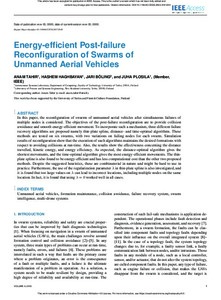Energy-efficient Post-failure Reconfiguration of Swarms of Unmanned Aerial Vehicles
Tahir Anam; Haghbayan Hashem; Böling Jari; Plosila Juha
https://urn.fi/URN:NBN:fi-fe2022081154800
Tiivistelmä
In this paper, the reconfiguration of swarms of unmanned aerial vehicles after simultaneous failures of multiple nodes is considered. The objectives of the post-failure reconfiguration are to provide collision avoidance and smooth energy-efficient movement. To incorporate such a mechanism, three different failure recovery algorithms are proposed namely thin-plate spline, distance- and time-optimal algorithms. These methods are tested on six swarms, with two variations on failing nodes for each swarm. Simulation results of reconfiguration show that the execution of such algorithms maintains the desired formations with respect to avoiding collisions at run-time. Also, the results show the effectiveness concerning the distance travelled, kinetic energy, and energy efficiency. As expected, the distance-optimal algorithm gives the shortest movements, and the time-optimal algorithm gives the most energy-efficient movements. The thinplate spline is also found to be energy-efficient and has less computational cost than the other two proposed methods. Despite the suggested heuristics, these are combinatorial in nature and might be hard to use in practice. Furthermore, the use of the regularization parameter λ in thin-plate spline is also investigated, and it is found that too large values on λ can lead to incorrect locations, including multiple nodes on the same location. In fact, it is found that using λ = 0 worked well in all cases.
Kokoelmat
- Rinnakkaistallenteet [27094]
